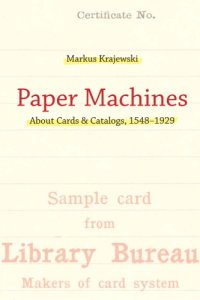
Ebook: Paper machines: about cards & catalogs, 1548-1929
Author: Krajewski Markus
- Tags: Card catalogs, Catalog cards, Information organization, Fichas (Catálogos), Organización del conocimiento, Historia, Fichas (Catálogos), Organización del conocimiento, Catalog cards -- History, Card catalogs -- History, Information organization -- History
- Series: History and foundations of information science
- Year: 2011
- Publisher: MIT Press
- City: Cambridge;Mass
- Language: English
- pdf
Today on almost every desk in every office sits a computer. Eighty years ago, desktops were equipped with a nonelectronic data processing machine: a card file. Traces the evolution of this proto-computer of rearrangeable parts (file cards) that became ubiquitous in offices between the world wars. Begins with Konrad Gessner, a sixteenth-century Swiss polymath who described a new method of processing data: to cut up a sheet of handwritten notes into slips of paper, with one fact or topic per slip, and arrange as desired. In the late eighteenth century, the card catalog became the librarian's answer to the threat of information overload. Then, at the turn of the twentieth century, business adopted the technology of the card catalog as a bookkeeping tool. Explores this conceptual development and casts the card file as a "universal paper machine" that accomplishes the basic operations of Turing's universal discrete machine: storing, processing, and transferring data. In telling his story, takes the reader on a number of illuminating detours, telling us, for example, that the card catalog and the numbered street address emerged at the same time in the same city (Vienna), and that Harvard University's home-grown cataloging system grew out of a librarian's laziness; and that Melvil Dewey (originator of the Dewey Decimal System) helped bring about the technology transfer of card files to business. [editor].;From library guides to the bureaucratic era:an introduction. -- Temporary indexing. -- Around 1800. The first card index?. -- Thinking in boxes. -- American arrival. -- Around 1900. Institutional technology transfer. -- Transatlantic technology transfer. -- Paper slip economy.
Download the book Paper machines: about cards & catalogs, 1548-1929 for free or read online
Continue reading on any device:

Last viewed books
Related books
{related-news}
Comments (0)